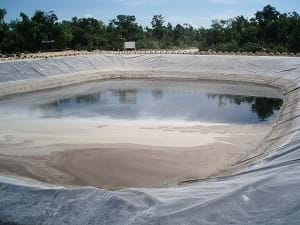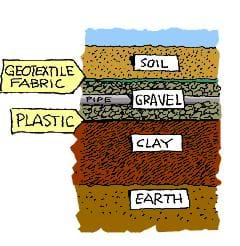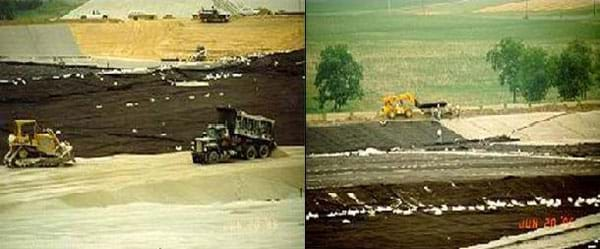Quick Look
Grade Level: 6 (5-7)
Time Required: 45 minutes
Expendable Cost/Group: US $10.00
Group Size: 2
Activity Dependency:
Subject Areas: Earth and Space
NGSS Performance Expectations:

| MS-ETS1-4 |

Summary
Students construct model landfill liners using tape and strips of plastic, within resource constraints. The challenge is to construct a bag that is able to hold a cup of water without leaking. This represents similar challenges that environmental engineers face when piecing together liners for real landfills that are acres and acres in size.Engineering Connection
When designing liners for a sanitary landfills, engineers face many challenges. They continuously develop better ways to make liners to keep harmful chemicals from leaking and contaminating groundwater supplies.
Learning Objectives
After this activity, students should be able to:
- Understand how landfills can pollute groundwater.
- Describe leachate and how it becomes polluted.
- Use the engineering design process to design a prototype plastic landfill liner.
- Collect data by measuring volume of water retained by their model.
Educational Standards
Each TeachEngineering lesson or activity is correlated to one or more K-12 science,
technology, engineering or math (STEM) educational standards.
All 100,000+ K-12 STEM standards covered in TeachEngineering are collected, maintained and packaged by the Achievement Standards Network (ASN),
a project of D2L (www.achievementstandards.org).
In the ASN, standards are hierarchically structured: first by source; e.g., by state; within source by type; e.g., science or mathematics;
within type by subtype, then by grade, etc.
Each TeachEngineering lesson or activity is correlated to one or more K-12 science, technology, engineering or math (STEM) educational standards.
All 100,000+ K-12 STEM standards covered in TeachEngineering are collected, maintained and packaged by the Achievement Standards Network (ASN), a project of D2L (www.achievementstandards.org).
In the ASN, standards are hierarchically structured: first by source; e.g., by state; within source by type; e.g., science or mathematics; within type by subtype, then by grade, etc.
NGSS: Next Generation Science Standards - Science
| NGSS Performance Expectation | ||
|---|---|---|
|
MS-ETS1-4. Develop a model to generate data for iterative testing and modification of a proposed object, tool, or process such that an optimal design can be achieved. (Grades 6 - 8) Do you agree with this alignment? |
||
| Click to view other curriculum aligned to this Performance Expectation | ||
| This activity focuses on the following Three Dimensional Learning aspects of NGSS: | ||
| Science & Engineering Practices | Disciplinary Core Ideas | Crosscutting Concepts |
| Develop a model to generate data to test ideas about designed systems, including those representing inputs and outputs. Alignment agreement: | Models of all kinds are important for testing solutions. Alignment agreement: The iterative process of testing the most promising solutions and modifying what is proposed on the basis of the test results leads to greater refinement and ultimately to an optimal solution.Alignment agreement: | |
Common Core State Standards - Math
-
Find a percent of a quantity as a rate per 100 (e.g., 30% of a quantity means 30/100 times the quantity); solve problems involving finding the whole, given a part and the percent.
(Grade
6)
More Details
Do you agree with this alignment?
International Technology and Engineering Educators Association - Technology
-
The management of waste produced by technological systems is an important societal issue.
(Grades
6 -
8)
More Details
Do you agree with this alignment?
-
Modeling, testing, evaluating, and modifying are used to transform ideas into practical solutions.
(Grades
6 -
8)
More Details
Do you agree with this alignment?
-
Analyze how the creation and use of technologies consumes renewable and non-renewable resources and creates waste.
(Grades
6 -
8)
More Details
Do you agree with this alignment?
-
Analyze examples of technologies that have changed the way people think, interact, and communicate.
(Grades
6 -
8)
More Details
Do you agree with this alignment?
State Standards
Colorado - Math
-
Find a percent of a quantity as a rate per 100.
(Grade
6)
More Details
Do you agree with this alignment?
Colorado - Science
-
Model equilibrium in an ecosystem, including basic inputs and outputs, to predict how a change to that ecosystem such as climate change might impact the organisms, populations, and species within it such as the removal of a top predator or introduction of a new species
(Grade
6)
More Details
Do you agree with this alignment?
-
Identify the various causes and effects of water pollution in local and world water distributions
(Grade
6)
More Details
Do you agree with this alignment?
Materials List
For the entire class to share:
- measuring cup or graduated cylinder to measure water poured into plastic bags
- measuring cup or graduated cylinder to measure water that has leaked
- water supply source (sink or jug of water)
Each group/individual should have:
- 5 2"-wide garbage bag strips
- 1 12" length of masking tape
Pre-Req Knowledge
Students should have basic knowledge of how groundwater flows (see the "An Underground River" lesson of this unit) and basic multiplication and division skills.
Introduction/Motivation
Every landfill built today is required to have an EPA-certified liner. Each layer has a distinct purpose to stop leachate (the water that seeps through the garbage) from reaching the underlying groundwater. Leachate is often highly polluted with toxic chemicals that can be harmful to people. Can you think of why this is? Well, leachate is often produced by the water run-off of rainwater or precipitation that flows through the garbage pile. What kinds of things do you throw into the garbage? Well, rotting food will contain bacteria that get into leachate, and any item that is not completely rinsed out will add chemicals to leachate. What about thrown-away medications, used bandaids, broken thermometers, dirty diapers and all the other icky stuff we put into the trash! Also, as items degrade, the chemicals that make them will break down into the leachate. Would you want all of these leachate contaminants in your drinking water?

Engineers have designed landfill liners that consist of several layers. First, landfills have a layer of ordinary soil as a foundation for the waste. The next few layers include a filter layer called a geotextile (a synthetic permeable membrane) layer that is meant to allow water through and filter out any particles of trash; a leachate collection layer or system, which has permeable gravel that allows water to seep through; and pipes to collect the water or leachate that can be sent off and treated. Lastly, liners are required to have two barriers layers: a plastic layer and a thick layer of impermeable clay.
The EPA put a lot of thought into how to construct a liner; you would think, therefore, that if they did a pretty good job, the water would not flow through plastic, right? And even if it did leak, there is a thick clay layer to stop the water there, too. Unfortunately, all liners leak! How is this possible? Imagine trying to lay down plastic over an areas that is the size of an entire football field. Plastic wide enough to cover a football field does not exist, so engineers must piece it together. Not only is difficult to make perfect seams when taping plastic together, it is also very easy to puncture or tear the plastic when it is installed. Generally, there is a lot of room for defects in the plastic liners. Engineers are continuously working on better ways to make plastic liners for sanitary landfills. This is important to keep harmful contaminants from our groundwater supplies. Today, we are going to make plastic liners of our own and determine if we can make one that can hold water with no leaking!

Procedure
Before the Activity
- Cut the plastic garbage bags into 2"-wide strips. (Note: The length of the strips will vary depending on the garbage bag and how you cut them, but try to make the stripes equal in length.)
- Measure and cut a 12" length of masking tape for each group.
- Make an example bag using five strips.
With the Students
- Review the layers of a landfill liner with the students.
- Give each pair of students five 2"-wide strips of garbage bag plastic and 12" of masking tape.
- Instruct students that they are environmental engineers who are working to build a thin plastic liner layer for a sanitary landfill using limited materials (a liner that is cost effective). Instruct them to make a plastic bag that can hold one cup of water without leaking. Ask the students to think about why a bag might leak while making their designs. If competition works well in your classroom, tell the students the bag that leaks the least amount of water wins (you determine the prize).
- Have teams test bags as soon as they have one together.
- To test the bags, have one student hold the bag over a large beaker or measuring cup. Have the teacher or another student pour exactly one cup of water into the constructed plastic bag. Time one minute and then measure the water that leaked through the bag. Have students record their data on paper or on the board.
- Have students redesign their liners as many times as time allows. They can opt to fix leaks in their existing bags or construct new bags.
- With five minutes left, have students clean up. Announce the winner if one, and ask students where they thought their bags leaked. (Answer: Hopefully students observed that the seams between the strips leaked the most.)
- Ask students if they think real landfill liners will leak. (Answer: All liners constructed have leakage.) Ask students why they think landfill liners leak? (Answer: Students may come up with the seams or defects in the liner.) Ask students to imagine trying to design the same type of liner for a landfill the size of a football field or larger. Would it leak? Remind students that creating a liner like this is one challenge that environmental engineers face when developing sanitary landfills.
Vocabulary/Definitions
Leachate: Water produced by leaching or filtering through a landfill. Often contains high amounts of organic matter and toxic chemicals.
Assessment
Pre-Activity Assessment
Idea Web: Ask students to brainstorm a list of pollutants that could get into groundwater from a landfill. What effects do these pollutants have on us and our environment? What are possible solutions for reducing these types of pollutants?
Activity Embedded Assessment
Re-Engineering: Ask students how they could improve their landfill liners and have them redesign and test their ideas. Casually monitor how many times students test their bags. Each team should test its bag at least once.
Post-Activity Assessment
Show and Tell: Have students "show and tell" to the rest of the class the landfill liners they created, explaining their work to the other students.
Drawing: Have students draw a picture of a landfill. Then, ask them to draw an engineering liner system in their picture and name as many of the layers as they can. If time allows, have them use arrows to represent the flow of contaminants through the landfill into the groundwater and associated aquifer. Have them name the path of groundwater as well.
Fix the Leak: Have students brainstorm ideas to design a sanitary landfill liner and leachate treatment system for a landfill that has mostly waste from household garbage. First, assign one student in the group to be the recorder. Then have someone toss out an idea. Next, another person in the group provides an idea that builds on the first. Go around the group in this fashion until all students have put in enough ideas to put together a design. When they are done, have them share their ideas with the class.
Safety Issues
- Students should not drink the water used for the landfill tests.
Troubleshooting Tips
If students are having difficulty constructing their liners, give more or less tape and garbage bags strips. Most of the bags should leak, if they are perfect (and do not leak), give fewer supplies.
At first, students will have trouble thinking of how to construct a bag. If they can not come up with anything, give more instruction at the beginning of the activity.
Activity Extensions
Have students research other garbage disposal methods. Have them create a chart with a row for each method of disposing garbage and a column for pros and cons. Require at least one pro and one con for each row. Pros and cons might include: high cost vs. low cost, creating pollution vs. not creating pollution, and a permanent solution vs. a solution that may induce future problems.
Have students build model landfills by placing their liners across cups or basins. Do not stretch the liners tightly, but allow them to sag in the middle to hold their experimental "garbage." Pour in different "waste" waters, including detergent, soda, bleach or anything else and see if the liners are affected by common household products over a period of a few days. Have students test the resulting leachate for pH.
Activity Scaling
- For younger students, give students more guidance on how to build a bag. It may be necessary to give step-by-step instructions.
- For older students, require students to draw blueprints of the design before starting construction, and discuss the designs as a class. For extra math practice, have students determine the percent of water that they were able to retain in their model liners for each time they designed or re-designed them. (Volume of leaked water divided by original volume of water poured; then multiplied by 100.) Did the percentage of their trials improve?
Subscribe
Get the inside scoop on all things TeachEngineering such as new site features, curriculum updates, video releases, and more by signing up for our newsletter!More Curriculum Like This

In this lesson, students learn about the three methods of waste disposal in use by modern communities. They also investigate how engineers design sanitary landfills to prevent leachate from polluting the underlining groundwater.

In this lesson, students explore solid waste and its effects on the environment. They collect classroom trash for analysis and build model landfills in order to understand the process and impact of solid waste management.

Students design and build model landfills using materials similar to those used by engineers for full-scale landfills. Teams create designs within given budgets, test the landfills' performance, and graph and compare designs for capacity, cost and performance.

Through the use of models and scientific investigation, students explore the causes of water pollution and its effects on the environment. Through the two associated activities, they investigate filtration and aeration processes that are used for removing pollutants from water.
References
Environmental Research and Education Foundation, Educational Activities, accessed November 6, 2005. http://www.erefdn.org/educationact1/activity1onpdf.htm
U.S. Environmental Protection Agency, accessed November 6, 2005. http://www.epa.gov
U.S. Environmental Protection Agency, Superfund (Cerclis), Petitioned Public Health Assessment: Fresh Kills Landfill, Summary, Staten Island, Richmond County, New York, Petition Response Section, Exposure Investigation and Consultation Branch, Division of Health Assessment and Consultation, Agency for Toxic Substances and Disease Registry, May 2000. http://www.atsdr.cdc.gov/HAC/PHA/freshkills/fkl_p1.html
Copyright
© 2005 by Regents of the University of Colorado.Contributors
Malinda Schaefer Zarske; Janet Yowell; Melissa StratenSupporting Program
Integrated Teaching and Learning Program, College of Engineering, University of Colorado BoulderAcknowledgements
The contents of this digital library curriculum were developed under a grant from the Fund for the Improvement of Postsecondary Education (FIPSE), U.S. Department of Education and National Science Foundation GK-12 grant no. 0338326. However, these contents do not necessarily represent the policies of the Department of Education or National Science Foundation, and you should not assume endorsement by the federal government.
Last modified: April 14, 2019










User Comments & Tips